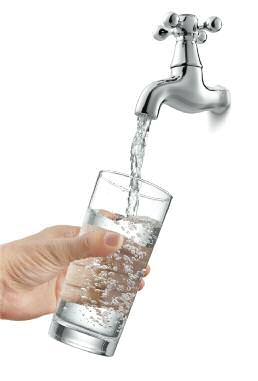ON TOP
Clean water springs from our faucets.
WRITTEN BY AMY HARRIS
Bottled water labels promise liquid from pristine springs. Poland Spring’s label says its fountainhead is composed of 100 percent natural spring water, Aquafina’s label says it offers pure water with a “perfect taste,” and Dasani’s label says it has purified water with a “fresh taste.” But where can you get spring water from the snow-capped peaks of Lake Tahoe? It turns out that our tap provides fresh, pure water for the cost of the regular water bill.
“Most of our water comes from the snow pack around Lake Tahoe,” says Julie Stoughton, an environmental science professor at the University of Nevada, Reno. “The fresh snowmelt flows down the Truckee River.”
A total of 85 percent of Reno’s water supply comes from the Truckee River. The other 15 percent comes from wells. The sources are mixed together and then filtered, screened, coagulated, flocculated, mixed, and filtered again. Public water is consistently tested.
“The public water supply always has to meet strict standards,” says Dr. Mark Walker, a water specialist and professor at UNR. “Before the water ever gets into your tap it’s tested a bunch of times. I have confidence I can go anywhere and get a glass of water and chances are I’m not going to get sick.”
Water in many places is contaminated by industrial, agricultural, or mining run-off, Stoughton says.
“But upstream from Reno we don’t really have to worry about any of these issues,” she says.
Sometimes bottled water is just tap water and “treated” water is often hooked up to the public water supply, Walker says. This means the only difference between the tap water from the faucet and the “pure” water from the store is the few bucks extra you pay for the brand and labeling.
Imperfect solutions
But it is important to understand that even the purest, most treated and filtered water still has “stuff” in it, Walker says.
“You have to understand that water is a universal solvent,” he says. “It dissolves everything.”
Water is an expression of its environment. But this doesn’t mean the water is dangerous. Public water treatment facilities ensure the concentrations of harmful solvents are so low that health effects from them are negligible. Treatment facilities are overly cautious and concerned with safety.
Because of the source (fresh water from the mountains around Lake Tahoe) along with rigid public water safety requirements, we receive the type of water that bottled water makers claim on their labels: perfect taste, purity, and freshness.
“We have great tap water,” Stoughton says. “We’re pretty lucky.”
And Paul Miller, manager of operations and water quality at Truckee Meadows Water Authority in Reno, says, “We are fortunate to have a great raw water supply, excellent treatment facilities, and highly skilled employees who work hard to consistently deliver high-quality water. We are very proud of the product that we deliver to 330,000 residents every day.”
For details on local water quality, visit Truckee Meadows Water Authority at www.Tmwa.com , Truckee Donner Public Utility District at Tdpud.org, Truckee Carson Irrigation District at Tcid.org, Carson City Public Works at www.Carson.org/index.aspx?page=191 , or your local water agency.
Amy Harris is a writer and student at UNR. For more than a decade she has sipped water from the snow-covered peaks of Lake Tahoe and thinks it’s the best water in the world.


